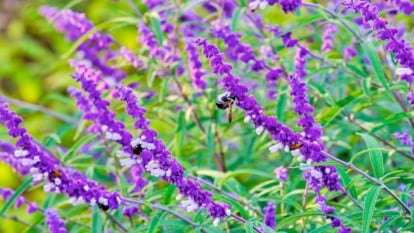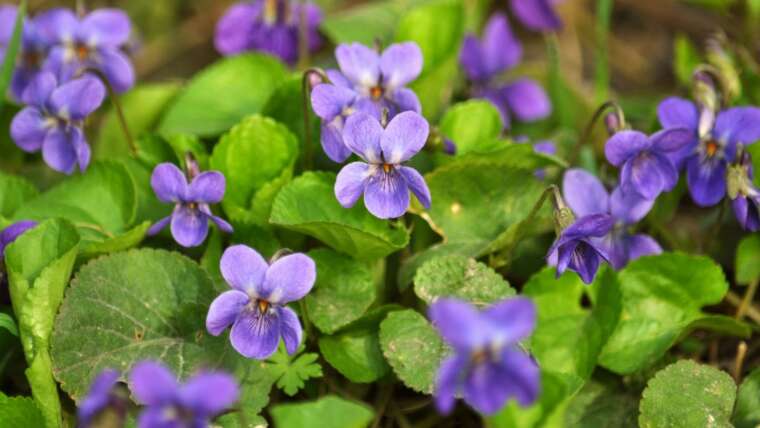Mexican bush sage is a tropical or subtropical shrub in Lamiaceae, the mint family. This perennial is covered in funnel-shaped purple flowers all through summer and into fall. Though it won’t survive the winter in cooler areas, gardeners often grow it as an annual.
Pollinators flock to this shrub, particularly hummingbirds and butterflies. This makes this Salvia an excellent choice not just for borders and in front of homes, but also anywhere you want pollinators to go. You could even plant it near your veggies to entice the bees.
Best of all, this perennial is super easy to care for once established. There’s not much it needs from you aside from water and a sprinkling of fertilizer here and there. As the years go on, you can divide it and grow it in other areas of your garden or even create a border.
A mature specimen will be about four to six feet tall and a few feet wide, but it will clump up over the years and get even bigger, especially in full sun. Treat Mexican sage bush right, and you’ll be enjoying its purple flowers for many years. We’ve assembled everything you need to know about this tropical shrub.
Mexican Bush Sage Overview
| | |
What Is It?
 Purple flowers attract hummingbirds and butterflies from summer to fall.
Purple flowers attract hummingbirds and butterflies from summer to fall.
S. leucantha, known as Mexican bush sage or velvet sage, is a flowering perennial in the mint family that thrives in warmer regions of the United States. It’s known for being a low-maintenance shrub with purple flowers that act like a magnet for hummingbirds and butterflies. The flowers bloom in summer and remain until fall, during which time they take a bicolor form with some white petals.
Characteristics
 It is a dense shrub with purple flowers, perfect for borders and gardens.
It is a dense shrub with purple flowers, perfect for borders and gardens.
Mexican bush sage is a perennial in USDA hardiness zones 8 through 10, though it’s often grown as an annual in colder regions. This dense, spreading shrub is frequently planted as a back border, reaching about four feet in height, or as part of pollinator gardens. Hummingbirds and butterflies are attracted to its funnel-shaped purple flowers, which emerge in summer and remain through fall.
Native Area
 The hardy shrub thrives in mild climates with average water.
The hardy shrub thrives in mild climates with average water.
This perennial is native to tropical and subtropical conifer forests in Mexico and Central America. These regions experience fairly warm temperatures with some variability, as well as lower precipitation than in tropical rainforests.
As such, this shrub is hardy in the mild climates of zones 8 through 10 and appreciates an average amount of water.
Planting
Mexican bush sage is easy to plant, whether transplanting or starting from seed. These perennials will do best in a location that receives at least six hours of direct sunlight per day. If you are growing as an annual, do not transplant until well after the last frost.
You could plant this fairly large shrub in a big container as an annual, but note that it can reach up to three feet in height and width.
Transplanting
 Transplant in early spring to ensure robust summer blooms.
Transplant in early spring to ensure robust summer blooms.
The best time of year to transplant is early spring, so the plant has enough time to establish its root system before summer blooming. Choose a sunny location with well-draining soil. If transplanting multiple, leave a few feet between each.
Dig a hole that’s slightly larger than the root ball. Place the plant upright in the hole, backfill it with soil, and water in the transplant. For the next few months, water it regularly while it settles. This shrub is low-maintenance once established.
Growing From Seed
 Start seeds indoors six weeks before the last frost.
Start seeds indoors six weeks before the last frost.
You can also start Mexican bush sage from seed. Ideally, start seeds indoors about six weeks before your last frost date. Fill seed starting trays with moist seed starting mix. Plant the seeds about ⅛ inch deep, and keep the soil moist until germination.
Keep the seedlings in a sunny window or under grow lights until it’s safe to move them outside or transplant them into the garden. They need light to germinate, so ensure they have plenty of sunlight or a good grow light. If they outgrow the trays before it’s safe to transplant, repot into smaller indoor pots.
How to Grow
Growing Mexican sage bush is a breeze. Plant it in the right sun exposure and in the proper soil, and all you really need to do is water it. Some yearly fertilizer and optional pruning are the only other chores on your to-do list.
Light
 Full sun ensures the best growth for this perennial.
Full sun ensures the best growth for this perennial.
This perennial will form best in a full sun location, especially if growing as an annual in a cooler zone. It will grow in partial shade and even appreciates shade in the hottest areas of its range. In zones 9 and 10, plant somewhere that is protected from midday sun.
Water
 Once established, this plant needs minimal weekly watering.
Once established, this plant needs minimal weekly watering.
Mexican bush sage is native to tropical and subtropical conifer forests. It prefers some moisture in the soil, but it doesn’t need as much water as you’d think for a typical tropical plant. Once established, you only need to water it once a week or so, excluding when it rains.
Soil
 This plant thrives in loamy, well-draining, slightly alkaline soil.
This plant thrives in loamy, well-draining, slightly alkaline soil.
This perennial prefers loamy, nutrient-rich soil that retains some moisture but drains thoroughly. Soil should be neutral or slightly alkaline but not acidic. In containers, a standard container potting mix with slow-release fertilizer pellets should suffice, especially for one season as an annual.
Temperature and Humidity
 Grow this species in warm, humid conditions within its hardiness zone.
Grow this species in warm, humid conditions within its hardiness zone.
Ideally, this plant should be kept in warm temperatures and above-average humidity. Fortunately, it’s not extremely picky and will be just fine in most areas within its hardiness zone: 8 through 10.
Mexican bush sage won’t survive the winter in colder areas. If you’re on the border of where it’s hardy, apply much before winter to help keep the roots warm.
Fertilizing
 A yearly application of slow-release fertilizer ensures vibrant blooms.
A yearly application of slow-release fertilizer ensures vibrant blooms.
If growing as a perennial, a yearly application of all-purpose, slow-release fertilizer in early spring will be more than enough to boost the shrub through the growing season. You could also amend the soil with compost.
Mexican bush sage may have trouble flowering with excessive fertilizer in the same spot. Salvias generally do not need supplemental fertilizers, as they’re tough plants that grow in less than optimal conditions. As an annual, there’s no need to fertilize this shrub.
Maintenance
 This easy-going shrub thrives with minimal maintenance and occasional pruning.
This easy-going shrub thrives with minimal maintenance and occasional pruning.
This is an easy-going plant. If you’d prefer, you could really skip maintenance entirely.
Annual pruning in spring can keep the plant looking tidy. If you’re growing a healthy plant in a perennial area, you can shape it to your preference or even cut it a few inches from the ground for all fresh growth. The shrub will bounce back.
Deadheading spent flowers throughout summer and fall will keep Mexican sage bush producing more flowers, but it’s not required. It will continue to flower whether you deadhead it or not.
Propagation
This perennial is easy to propagate. You can divide it in spring or in fall, and it’s also possible to start new plants from cuttings.
This shrub makes a lovely back border plant, so you may want to propagate a couple of plants you have into a row. Once you see how much pollinators enjoy this shrub, you may want to propagate it to other areas of your yard.
Cuttings
 Healthy cuttings root well in warm, humid conditions.
Healthy cuttings root well in warm, humid conditions.
The steps for propagating Mexican sage bush via cuttings are fairly typical. Using clean pruners, sever healthy, 8-inch cuttings. Remove the leaves from the bottom half of the cutting. Optionally, apply rooting hormone to the bottom tips of the cutting.
Place your cuttings in a pot (or multiple pots) of moist potting soil. Keep the pot in a warm, humid area until the cutting begins to root. Keep the soil moist during this time. Once the cuttings have rooted, move them into a sunny location.
Transplant once the cutting is well-established or begins to outgrow its vessel.
Division
 Split in spring or fall, replant in well-drained soil.
Split in spring or fall, replant in well-drained soil.
Divide Mexican bush sage in early spring, giving it enough time to establish before summer blooming. Alternatively, divide in late fall once the blooming period is complete.
To do so, dig up the entire plant, and do your best to avoid damaging any roots. Shake off some of the excess soil, and use a clean spade or knife to cut the root ball into two or three divisions. Plant the divided pieces in sunny locations in well-draining soil.
Water in the recent transplants well. Keep their soil moist for a few weeks, and then care for the young shrubs as you would otherwise.
Popular Varieties
These cultivars are striking and vigorous for season-long displays.
‘All Purple’
 The cultivar features vibrant purple blooms all season.
The cultivar features vibrant purple blooms all season.
The standard S. leucantha has purple blooms in summer and bicolor blooms in fall, with some of the petals emerging white. The ‘All Purple’ cultivar, as the name suggests, has purely purple blooms all season. If you’re exclusively in it for the purple flowers, then this cultivar may be for you.
‘Danielle’s Dream’
 This cultivar offers delicate white and pink flowers throughout season.
This cultivar offers delicate white and pink flowers throughout season.
On the other hand, ‘Danielle’s Dream’ produces all-white flowers in the summer, followed up by white and pink bicolor flowers in the fall. In this cultivar, white replaces the traditional purple, while pink replaces the traditional white. The resulting dainty flowers are subtle and add variety to the garden.
‘Santa Barbara’
 The plant features compact blooms in a vibrant pinkish-purple.
The plant features compact blooms in a vibrant pinkish-purple.
Lastly, ‘Santa Barbara’ more closely resembles ‘All Purple’ when it comes to bloom colors, though the fall corollas are a pinker shade of purple, and there are still white blooms. This cultivar is also a bit more compact and dense.
Common Problems
This perennial doesn’t suffer from many common problems. Though it’s in the mint family, it’s not an aggressive spreader. As long as you’re providing the proper conditions, this shrub should be fine.
There are a few pests that may be attracted to Mexican sage bush, and it’s subject to fungal diseases if too densely planted or if the foliage is consistently wet.
Pests
 Pests like aphids and mealybugs can be treated with insecticidal soap.
Pests like aphids and mealybugs can be treated with insecticidal soap.
Mexican sage bush rarely struggles to a significant degree with pests. However, classic garden pests such as whiteflies, aphids, mealybugs, and spider mites may appear. You may notice damaged foliage, slowed growth, or the pests themselves.
You can usually treat all these pets with insecticidal soap, harsh sprays of water, and other gentle pest-removal methods without restoring to pesticides.
Diseases
 Good air circulation and base watering prevent powdery mildew.
Good air circulation and base watering prevent powdery mildew.
This perennial is also pretty disease-resistant, but there are a few diseases related to lack of air circulation and over-watering that you may discover:
- Rust: You may see white, yellow, or reddish spots on the leaves. Growth will slow over time if rust takes hold, leading to death. Improve air circulation via pruning and water the soil, not the leaves, to minimize spread.
- Powdery mildew: You will see what looks like gray or white powder dusted on the leaves. This is not extremely damaging but does slow down growth. Provide good air circulation and water at the base of the plant. Prune away damaged or diseased areas as needed.
- Stem rot: If the entire plant suddenly goes yellow and rots, then it probably developed stem rot from excess moisture in the soil. Avoid this by planting in well-draining soil.
- Fungal leaf spot: If you discover brown spots on leaves, it may be fungal leaf spot. Increase air circulation throughout the plant and do not water foliage directly.
Frequently Asked Questions
This shrub is a perennial that will come back year after year in zones where it’s hardy, which includes zones 8 through 10. If kept healthy, gardeners in these regions can expect their shrubs to live for years. If you live somewhere cooler, you can grow it as an annual, knowing that it will not return in spring.
Mexican sage bush will spread over time from the base of the plant, slowly getting wider and more dense. You probably will not find it appearing in other areas of your garden, and it will not spread via underground rhizomes like other members of the mint family. If your shrub becomes quite large, you can easily divide it.
This plant will survive a freeze and can make it through freezing conditions for a little while, but it won’t survive harsh winters. This tropical plant will not survive the winter if planted in zone 6. In zone 7, consider mulching around your plant to help it get through the coldest months.
This perennial is non-toxic to dogs and cats. There’s no reason to worry about planting it if you have pets.
This question depends on where you live. As an annual, it prefers as much sun as possible, or at least six hours of direct light. As a perennial, this shrub still prefers full sun, unless you are in one of the hotter regions where it’s hardy. If you’re growing it as a perennial in zones 9 or 10, plant it somewhere where it will get shade during the hottest periods of the day.




